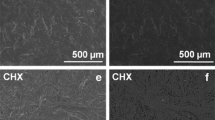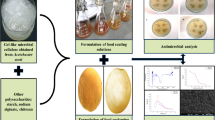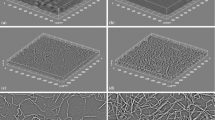Abstract
Food spoilage and foodborne diseases are caused by pathogenic microbial contaminations, which occur at multi-stages of the food supply chain. The development of materials with chlorine refreshable biocidal functions, which could be integrated with many current food processing procedures, are necessary for food contact surfaces, such as conveyor belts and food packages. Taking the advantages of biocidal activity and serviceability of a previously developed durable and regenerable biocidal antimicrobial cellulose fabric (DMH-g-Cotton fabric), we demonstrated a scalable strategy for fabrication of a chlorine rechargeable antimicrobial composite material consisting of the DMH-g-Cotton, serving as a reinforcement component and a reservoir of active chlorine, and an amine-halamine polymer (2,4-diamino-6-diallylamino-1,3,5-triazine) grafted poly(vinyl alcohol-co-ethylene, PVA-co-PE-g-DAM) as a coating component. The as-prepared halamine composite fabric (HCF) exhibited the integrated properties of a high content of active chlorine, ease of rechargeability, rapid biocidal efficacy even at high chemical oxygen demand condition, reduced cross-contamination risk, and desired mechanical properties. The halamine cellulose fabric played an important role to serve as a reinforcement material and active chlorine reservoir for the composite. Additionally, the incorporation of HCFs as a biocidal food pad was demonstrated to achieve the prolonged shelf life of prepackaged strawberries.
Graphic abstract





Similar content being viewed by others
References
Barbosa J, Albano H, Silva C, Teixeira P (2019) Microbiological contamination of reusable plastic bags for food transportation. Food Control 99:158–163. https://doi.org/10.1016/j.foodcont.2018.12.041
Bourdichon F, Rouzeau K (2012) Microbial food spoilage: a major concern for food business operators. New Food 15:54–57
Buzby JC, Wells HF, Bentley J (2013) ERS’s food loss data help inform the food waste discussion. https://www.ers.usda.gov/amber-waves/2013/june/ers-food-loss-data-help-inform-the-food-waste-discussion/
Dabral M, Francis L, Scriven L (2002) Drying process paths of ternary polymer solution coating. AIChE J 48:25–37. https://doi.org/10.1002/aic.690480105
Flores RA, Tamplin ML, Marmer BS, Phillips JG, Cooke PH (2006) Transfer coefficient models for Escherichia coli O157: H7 on contacts between beef tissue and high-density polyethylene surfaces. J Food Prot 69:1248–1255. https://doi.org/10.4315/0362-028X-69.6.1248
Gram L, Ravn L, Rasch M, Bruhn JB, Christensen AB, Givskov M (2002) Food spoilage—interactions between food spoilage bacteria. Int J Food Microbiol 78:79–97. https://doi.org/10.1016/S0168-1605(02)00233-7
Huang C, Chen Y, Sun G, Yan K (2019) Disinfectant performance of a chlorine regenerable antibacterial microfiber fabric as a reusable wiper. Materials 12:127. https://doi.org/10.3390/ma12010127
Hui F, Debiemme-Chouvy C (2013) Antimicrobial N-halamine polymers and coatings: a review of their synthesis, characterization, and applications. Biomacromol 14:585–601
Irwansyah I, Li YQ, Shi W, Qi D, Leow WR, Tang MB, Li S, Chen X (2015) Gram-positive antimicrobial activity of amino acid-based hydrogels. Adv Mater 27:648–654. https://doi.org/10.1002/adma.201403339
Kinsinger NM, Mayton HM, Luth MR, Walker SL (2017) Efficacy of post-harvest rinsing and bleach disinfection of E. coli O157: H7 on spinach leaf surfaces. Food Microbiol 62:212–220. https://doi.org/10.1016/j.fm.2016.10.019
Larsen MH, Dalmasso M, Ingmer H, Langsrud S, Malakauskas M, Mader A, Møretrø T, Možina SS, Rychli K, Wagner M (2014) Persistence of foodborne pathogens and their control in primary and secondary food production chains. Food Control 44:92–109. https://doi.org/10.1016/j.foodcont.2014.03.039
Liu M, Wang F, Liang M, Si Y, Yu J, Ding B (2020) In situ green synthesis of rechargeable antibacterial N-halamine grafted poly (vinyl alcohol) nanofibrous membranes for food packaging applications. Compos Commun 17:147–153. https://doi.org/10.1016/j.coco.2019.11.018
Ma Y, Li J, Si Y, Huang K, Nitin N, Sun G (2019) Rechargeable antibacterial N-halamine films with antifouling function for food packaging applications. ACS Appl Mater Interfaces 11:17814–17822. https://doi.org/10.1021/acsami.9b03464
Muhterem-Uyar M, Dalmasso M, Bolocan AS, Hernandez M, Kapetanakou AE, Kuchta T, Manios SG, Melero B, Minarovičová J, Nicolau AI (2015) Environmental sampling for Listeria monocytogenes control in food processing facilities reveals three contamination scenarios. Food Control 51:94–107. https://doi.org/10.1016/j.foodcont.2014.10.042
Nerin C, Aznar M, Carrizo D (2016) Food contamination during food process. Trends Food Sci Technol 48:63–68. https://doi.org/10.1016/j.tifs.2015.12.004
Padgett WM, Hamner W (1958) The infrared spectra of some derivatives of 1, 3, 5-triazine. J Am Chem Soc 80:803–808
Qiao M, Huang T-S (2016) Potential applications of N-halamines in food production, processing and packaging for improving food safety. Food Safety Magazine:34–38. https://www.foodsafetymagazine.com/magazine-archive1/augustseptember-2016/potential-applications-of-n-halamines-in-food-production-processing-and-packaging-for-improving-food-safety/. Accessed 18 July 2020
Qiao M, Liu Q, Yong Y, Pardo Y, Worobo R, Liu Z, Jiang S, Ma M (2018) Scalable and rechargeable antimicrobial coating for food safety applications. J Agric Food Chem 66:11441–11450. https://doi.org/10.1021/acs.jafc.8b03864
Qian L, Sun G (2003) Durable and regenerable antimicrobial textiles: synthesis and applications of 3-methylol-2, 2, 5, 5-tetramethyl-imidazolidin-4-one (MTMIO). J Appl Polym Sci 89:2418–2425. https://doi.org/10.1002/app.12405
Qian L, Sun G (2004) Durable and regenerable antimicrobial textiles: improving efficacy and durability of biocidal functions. J Appl Polym Sci 91:2588–2593. https://doi.org/10.1002/app.13428
Qian L, Sun G (2005) Durable and regenerable antimicrobial textiles: chlorine transfer among halamine structures. Ind Eng Chem Res 44:852–856. https://doi.org/10.1021/ie049493x
Ren T, Hayden M, Qiao M, Huang T-S, Ren X, Weese J (2018) Absorbent pads containing N-halamine compound for potential antimicrobial use for chicken breast and ground chicken. J Agric Food Chem 66:1941–1948. https://doi.org/10.1021/acs.jafc.7b05191
Save NS, Jassal M, Agrawal AK (2002) Polyacrylamide based breathable coating for cotton fabric. J Ind Text 32:119–138. https://doi.org/10.1106/152808302031657
Scallan E, Hoekstra RM, Angulo FJ, Tauxe RV, Widdowson MA, Roy SL, Jones JL, Griffin PM (2011) Foodborne illness acquired in the United States—major pathogens. Emerg Infect Dis 17:7. https://doi.org/10.3201/eid1701.p11101
Si Y, Cussu A, Nitin N, Ma Y, Zhao C, Chiou B, Cao T, Wang D, Sun G (2017) Mechanically robust and transparent N-halamine grafted PVA-co-PE films with renewable antimicrobial activity. Macromol Biosci 17:1600304. https://doi.org/10.1002/mabi.201600304
Si Y, Li J, Zhao C, Deng Y, Ma Y, Wang D, Sun G (2017) Biocidal and rechargeable N-halamine nanofibrous membranes for highly efficient water disinfection. ACS Biomater Sci Eng 3:854–862. https://doi.org/10.1021/acsbiomaterials.7b00111
Sun G, Xu X, Bickett JR, Williams JF (2001) Durable and regenerable antibacterial finishing of fabrics with a new hydantoin derivative. Ind Eng Chem Res 40:1016–1021. https://doi.org/10.1021/ie000657t
Tian H, Zhai Y, Xu C, Liang J (2017) Durable antibacterial cotton fabrics containing stable acyclic N-halamine groups. Ind Eng Chem Res 56:7902–7909. https://doi.org/10.1021/acs.iecr.7b00863
Wachtel MR, Charkowski AO (2002) Cross-contamination of lettuce with Escherichia coli O157: H7. J Food Prot 65:465–470. https://doi.org/10.4315/0362-028X-65.3.465
Wang H, Chen M, Jin C, Niu B, Jiang S, Li X, Jiang S (2018) Antibacterial [2-(methacryloyloxy) ethyl] trimethylammonium chloride functionalized reduced graphene oxide/poly (ethylene-co-vinyl alcohol) multilayer barrier film for food packaging. J Agric Food Chem 66:732–739. https://doi.org/10.1021/acs.jafc.7b04784
Wu H, Teng C, Liu B, Tian H, Wang J (2018) Characterization and long term antimicrobial activity of the nisin anchored cellulose films. Int J Biol Macromol 113:487–493. https://doi.org/10.1016/j.ijbiomac.2018.01.194
Wu H, Tian H, Li S, Wang Y, Ma Z, Song Z, Wang J (2020) Preparation, characterization and long-term antibacterial activity of nisin anchored magnetic cellulose beads. Cellulose 27:357–367. https://doi.org/10.1007/s10570-019-02788-0
Yi J, Huang K, Young GM, Nitin N (2020) Quantitative analysis and influences of contact dynamics on bacterial cross-contamination from contaminated fresh produce. J Food Eng 270:109771. https://doi.org/10.1016/j.jfoodeng.2019.109771
Acknowledgments
The research was financially supported by the Center for Produce Safety (2018-CPS07-0), and USDA-NIFA (2015-68003-23411).
Author information
Authors and Affiliations
Corresponding author
Ethics declarations
Conflict of interest
All the authors declare that they have no conflict of interest.
Additional information
Publisher's Note
Springer Nature remains neutral with regard to jurisdictional claims in published maps and institutional affiliations.
Electronic supplementary material
Below is the link to the electronic supplementary material.
Rights and permissions
About this article
Cite this article
Ma, Y., Melo Ramos, T., Amador, L. et al. Durable and chlorine rechargeable biocidal composite material for improved food safety. Cellulose 28, 503–515 (2021). https://doi.org/10.1007/s10570-020-03520-z
Received:
Accepted:
Published:
Issue Date:
DOI: https://doi.org/10.1007/s10570-020-03520-z




